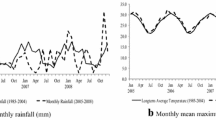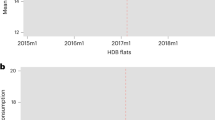Abstract
Economic theory generally assumes that consumers respond to marginal price, which is the price of the last unit of goods consumed, when making economic decisions. However, this assumption may not hold for goods with multi-block rate schedules. This paper explores the effects of water price information on residents’ behaviors under increasing block tariffs. The empirical evidence from the study suggests the middle-income groups respond to average price, which is based on the price level given by total fees divided by total consumption. This evidence supports the hypothesis that the incremental block tariffs are actually treated the same as uniform pricing for the middle-income group, while the highest income group is not sensitive to price changes. On the contrary, residents of the two lowest income groups respond to marginal price and probably go further to compare prices of different blocks and set consumption at kink points of price schedules to achieve maximal welfare. This study also finds that a higher second block price promotes consumption at kink points, and increased payments in first block consumption lead to less incentive to induce discrete choice behavior.


Similar content being viewed by others
Notes
‘RMB’ is the Chinese currency and the exchange rate is 6.3 RMB per dollar in 2011. Herein, we provide both values RMB (US$).
China is also facing non-revenue water which is a crucial parameter to generate a socially fair water pricing. In the case of the apparent loss, it can be noticed that the unauthorized consumption rarely happened because almost all the families have their water meters indoors and the water consumption is calculated from the meters which means that the reading from the meter is the volume that the family exactly consumed, this situation is experienced more by urban residents. The latest standard water meters (National Executive Standard Number is GB/T778.1 ~ 3) have been implemented in China from 2008 and showing a higher sensitivity. Recently, it seems that there are not important metering inaccuracies. In the case of real loses, (leakage on transportation, leakage and overflow at the storage unit and leakage in service connection) the data shows that China’s average urban water supply real loss rates from 2006 to 2009 are respectively 18.6 %, 17.6 %, 17.7 % and 16.2 %. There are 26 provinces of which real loss rates are higher than 12 % and 13 provinces higher than 20 % and only 5 provinces lower than 12 % which is the maximum acceptable rate defined by the Standard for Leakage Control and Assessment of Urban Water Supply Distribution System of China in 2009 (China Urban Water Association 2010).
During this study survey period, the daily maximum and minimum temperatures ranged respectively between 21 to 28 and 10 to 14 Celsius degrees (Beijing Meteorological Bureau 2011).
Because the water expenditure share (water expenditure divided by disposable income) is relatively low (there are approximately 90 % of residents whose water expenditure share is less than 2 % in our sample) under the current price. This study has not identified any water storage behaviors from the survey which may theoretically exist. In China if the water supply is going to be cut, the government will notice the residents in advance reminding them to store some water. Therefore, this paper argues if the difference between the block prices are high enough, this may arouse the behavior of water storage as they do in the water cut emergency. If the water consumption still have a gap to the nearest kink point, the consumers are likely encouraged to store certain amount of the resource to use it in the next month in order to avoid the excess that they can have if they don’t show this behavior.
The invalid samples include three types: 1) respondents encountered emergences when the survey was conducted; 2) respondents who were not urban residents of Beijing; 3) respondents who did not answer the behavior questionnaire because they had difficulties understanding the expressions that the researcher used.
The aim of the study is to identify the perceived price rather than to analyze the reasonable price schedule. Therefore, the eight experimental scenarios should include sufficient block and price variations.
References
Agthe DE, Billings RB (1987) Price elasticity and household income under increasing block rates for water. Am J Econ Sociol 46(3):273–286
Alberini A (1995) Testing willingness-to-pay models of discrete choice contingent valuation survey data. Land Econ 71(2):83–95
Arbués F, Villanúa I (2006) Potential for pricing policies in water resources management: estimation of urban residential water demand in Zaragoza, Spain. Urban Stud 43(13):2421–2442
Bank J, Blundell R, Lewbel A (1997) Quadratic Engel curves and consumer demand. Rev Econ Stat 79(4):527–539
Beijing Bureau of Civil Affairs Policy Document (2010) Notification on adjustment of minimal assurance standard. http://www.bjmzj.gov.cn/news/root/jzgfxwj/2011-10/100991.shtml (in Chinese). Accessed 24 December 2010
Beijing Meteorological Bureau. http://lishi.tianqi.com/beijing/index.html. (In Chinese), 2011
Beijing Water Authority (2013) Beijing Water Resources Bulletin 2012. http://www.bjwater.gov.cn/tabid/134/InfoID/18989/frtid/207/Default.asp. Accessed 17 September 2013 (in Chinese)
Billings RB, Agthe DE (1980) Price elasticities for water: a case of increasing block rates. Land Econ 56(1):73–84
Borenstein S (2009) To what electricity price do consumers respond? Residential demand elasticity under increasing-block pricing. Manuscript, University of California Energy Institute
Brown FL, Hoffman L, Baxter JD (1975) New way to measure price elasticity. Electrical World 184(12):52–54
Carter DW, Milon JW (2005) Price knowledge in household demand for utility services. Land Econ 81(2):265–283
Charles AM (1995) Which tax rate do people use: average or marginal? J Public Econ 56(1):79–96
Chen H, Yang ZF (2009) Residential water demand model under block rate pricing: a case study of Beijing, China. Commun Nonlinear Sci Numer Simul 14:2462–2468
Chetty R, Friedman JN, Olsen T, Pistaferr L (2010) Adjustment costs, firm responses, and labor supply elasticities: evidence from Danish tax records. National Bureau of Economic Research, Working Paper, Series No. 15617
China Urban Water Association. China Statistic Yearbook on Urban Water Supply, Beijing, 2010
Dharmaratna D, Harris E (2012) Estimating residential water demand using the stone-geary functional form: the case of Sri Lanka. Water Resour Manag 26(8):2283–2299
Espey M, Espey J, Shaw WD (1997) Price elasticity of residential demand for water: a meta-analysis. Water Resour Res 33(6):1369–1374
Foster HS, Beattie BR (1981) On the specification of price in studies of consumer demand under block price schedules. Land Econ 57(4):624–629
Foster JHS, Beattie BR (1981) Urban residential demand for water in the United States: reply. Land Econ 76(2):257–265
Friedberg L (2000) The labor supply effects of the social security earnings test. Rev Econ Stat 82(1):48–63
Hewitt JA, Hanemann WM (1995) A discrete/continuous choice approach to residential water demand under block rate. Land Econ 71(2):173–192
Höglund L (1999) Household demand for water in Sweden with implications of a potential tax on water use. Water Resour Res 35(12):3853–3863
Kanninen BJ (1995) Bias in discrete response contingent valuation. J Environ Econ Manag 28(1):114–125
Koichiro I (2014) Do consumers respond to marginal or average price? Evidence from nonlinear electricity pricing. Am Econ Rev 104(2):537–563
Liebman JB, Zeckhauser RJ (2004) Schmeduling. Working Paper, Harvard University
Ma XZ, Zhang SQ, Mu Q (2012) Application of quadratic almost ideal demand system in analysis of demand elasticity of household water demand of Beijing. Acta Sci Nat Univ Pekin 48:483–490 (in Chinese)
Montginoul M (2007) Analyzing the diversity of water pricing structures: the case of France. Water Resour Manag 21(5):861–871
Michelsen AM, McGuckin T, Stumpf D (1999) Effectiveness of conservation programs municipal water demand. J Am Water Resour Assoc 35(3):593–603
National Development and Reform Commission Policy Documents (2009) Notification on the management of urban water supply price. www.sdpc.gov.cn/zcfb/zcfbtz/2009tz/t20090724_292524.htm (in Chinese). Accessed 06 July 2009
National Development and Reform Commission Policy Documents (2010) Notification on supporting policy measures of investment and financing of circular economy. http://www.sdpc.gov.cn/zcfb/zcfbtz/2010tz/t20100505_344919.htm (in Chinese). Accessed 19 April 2010
Nieswiadomy ML, Molina DJ (1989) Comparing residential water demand estimates under decreasing and increasing block rates using household data. Land Econ 65(3):280–289
Nieswiadomy ML (1992) Estimating urban residential water demand: effects of price structure, conservation and education. Water Resour Res 28(3):609–615
Nieswiadomy ML, Cobb SL (1993) Impact of pricing structure selectivity on urban water demand. Contemp Policy Iss 11(3):101–113
Ortega V, Sumpsi CJ, Garriod A et al (1998) Water pricing policies, public decision making and farmers response: implications for water policy. Agric Econ 19(2):193–202
Pashardes P, Koundouri P, Hajispyrou S (2002) Household demand and welfare: implications of water pricing in Cyprus. Environ Dev Econ 7(4):659–685
Rietveld P, Rouwendal J, Zwart B (2000) Block rate pricing of water in Indonesia: an analysis of welfare effects. Bull Indones Econ Study 36(3):73–92
Rinaudo JD, Neverre N, Montginoul M (2012) Simulating the impact of pricing policies on residential water demand: a Southern France case study. Water Resour Manag 26(7):2057–2068
Saez E (2010) Do taxpayers bunch at kink point? Am Econ J Econ Pol 2:180–212
Shira ZB, Shtain IF, Simhon A (2006) Block-rate versus uniform water pricing in agriculture: an empirical analysis. Am J Agric Econ 88(4):986–999
Shin JS (1985) Perception of price when information is costly: evidence from residential electricity eemand. Rev Econ Stat 67(4):591–598
State Council Policy Documents (2002) Propelling price reform of urban water supply. http://www.gov.cn/gongbao/content/2003/content_62561.htm (in Chine-se). Accessed 01 April 2002
Stevens TH, Miller J, Willis C (1992) Effect of price structure on residential water demand. Water Resour Bull 28(4):681–685
Taylor RG, John R, McKean RA (2004) Alternate price specifications for estimating residential water demand with fixed fees. Land Econ 80(3):463–475
The Ministry of Water Resources of the People’s Republic of China (MWRC) (2011) Survey on recycled water . MWRC Website: http://www.mwr.gov.cn/slzx/mtzs/xhsxhw/201111/t20111103_309061.html. Accessed 03 November 2011 (in Chinese)
Zhang SQ, Swanson T et al (2006) Income related incidence of the welfare impacts of water pricing. Report of environmental and poverty program for China Council for International Cooperation on Environment and Development. Peking University
Acknowledgments
This study is a continuing effort of the cooperative study with University College London and University of Cambridge. We extend our gratitude to Professor Tim Swanson, Dr. Ben Groom and Dr. Andreas for their advice on approaches and methodologies and their efforts on the project for The China Council for International Cooperation on Environment and Development (CCICED). The authors are thankful for the valuable comments and editorial assistance of Mr. Peter Mauricio Larrea Parra. We also thank all members of the Environment and Economy Policy Study Group (EEPS) of Peking University for their contributions.
Author information
Authors and Affiliations
Corresponding author
Rights and permissions
About this article
Cite this article
Ma, X., Zhang, S. & Mu, Q. How Do Residents Respond to Price under Increasing Block Tariffs? Evidence from Experiments in Urban Residential Water Demand in Beijing. Water Resour Manage 28, 4895–4909 (2014). https://doi.org/10.1007/s11269-014-0561-y
Received:
Accepted:
Published:
Issue Date:
DOI: https://doi.org/10.1007/s11269-014-0561-y




